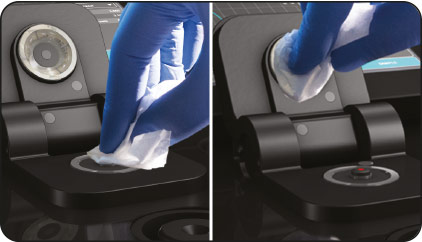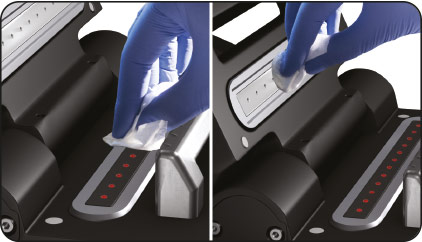Technical Note 11 – Cleaning of the NanoPhotometer® Microvolume Measurement Head for Nucleic Acid, Protein and Antibody Quantification
The microvolume measurement head of the NanoPhotometer® consists of scratch resistant quartz surfaces making it very easy to clean. In comparison to other technologies that are utilizing stainless steel, the inert NanoPhotometer® microvolume measurement head never needs to be reconditioned over the entire lifetime – even after the application of highly concentrated protein samples.
Important note:
All cleaning steps described below apply to both the pedestal and the lid mirror, since both surfaces are in touch with each sample.
Figure 1: The Pedestal and mirror of the NanoPhotometer® NP80, N60, or N50 are being cleaned with a lint-free tissue.

Figure 2: The Pedestal and mirror of the multi-channel NanoPhotometer® N120 are being cleaned with a lint-free tissue.
Cleaning Prior to Nucleic Acid Quantification
For nucleic acid samples, it is recommended to use a clean dry lint-free wipe (Kimwipe) between readings. If sample residues should build up causing fluctuations of readings, purified water is the best solvent for cleaning as alcohol could potentially precipitate the sample rather than removing it. If fingerprints or other artefacts should be visible on the measurement head, a 70% alcohol dampened wipe followed by a purified water wipe is advisable.
For dried-on nucleic acid samples (e.g. if a sample was left on the head overnight), pipette at least 5 µl of purified water on the pedestal to soak the sample for at least one minute. Apply several wiping steps to the pedestal and lid with purified water. Repeat the whole procedure as needed until the head is clean. If fingerprints or other artefacts should still be visible on the measurement head, a Kimwipe dampened with 70% alcohol followed by a fresh Kimwipe dampened with purified water step is advisable.
The final cleaning step should always be with purified water to ensure all of the alcohol has been removed as it potentially could interfere with the following reading. Always dry off residual water using a fresh Kimwipe.
To confirm that the head is clean run a blank with fresh purified water. Reapply a fresh drop of water and measure it as a sample. If the scan is not flat over the entire wavelength range and shows negative peaks, cleaning is not complete and needs to be repeated.
Note: please do not use ketones, DMSO or DMF for cleaning to avoid damage to the measurement head of the instrument.
Cleaning Prior to Protein and Antibody Quantification
Protein UV
For Protein UV samples it is recommended to use a Kimwipe dampened with purified water between each reading. If sample residue should build up (indicated by fluctuating readings) or fingerprints should be visible on the measurement window, apply a wipe with 70% alcohol.
For dried-on protein samples (e.g. if a sample was left on the head overnight), pipette at least 5 µl of purified water on the pedestal to soak the sample for at least one minute. Apply several wiping steps to the pedestal and lid with purified water. Repeat the whole procedure as needed until the head is clean.
If fingerprints or other artefacts should still be visible on the measurement head, a Kimwipe dampened with 70% alcohol followed by a fresh Kimwipe dampened with purified water step is advisable.
The final cleaning step should always be performed with purified water to ensure all of the alcohol has been removed as it potentially could interfere with the next reading. Always dry off residual water using a fresh Kimwipe. To confirm that the head is clean run a blank with fresh purified water. Reapply a fresh drop of water and measure it as a sample. If the scan is not flat over the entire wavelength range and shows negative peaks, cleaning is not complete and needs to be repeated.
Note: please do not use ketones, DMSO or DMF for cleaning to avoid damage to the measurement head of the instrument.
Protein Assay
The most common protein assays are either using coomassie dye or bicinchoninic acid to label free protein in the sample. It is therefore recommended to use a 70% alcohol dampened Kimwipe between readings to remove samples thoroughly. Several wipes might become necessary depending on the concentration of the sample, a visual inspection of the wipe after the reading is recommended until no dye remains are evident.
The final cleaning step should always be performed with purified water to ensure all of the alcohol has been removed. Alcohol potentially could interfere with readings using methods in the UV range. Always dry off residual water using a fresh Kimwipe.
Note: please do not use ketones, DMSO or DMF for cleaning to avoid damage to the measurement head of the instrument.
Small Molecules
The unique microvolume head design of the NanoPhotometer® allows for the measurement of small molecules in organic solvents in a drop. Please refer to our solvent compatibility list to avoid damages to the optical setup.
Most samples dissolved in alcohol, toluene or acetonitrile can be removed with a dry Kimwipe. If sample residue should build up (indicated by fluctuating readings) or fingerprints should be visible on the measurement window, apply one or several wipes with 70% alcohol until the head is clean and no further fluctuations are observed.
The final cleaning step should always be performed with purified water to ensure all of the alcohol has been removed as it potentially could interfere with the readings in the UV range. Always dry off residual water using a fresh Kimwipe.
Note: please do not use ketones, DMSO or DMF for cleaning to avoid damage to the measurement head of the instrument.
For further questions or if assistance is needed, please contact your local Implen Support Team at [email protected] or [email protected].